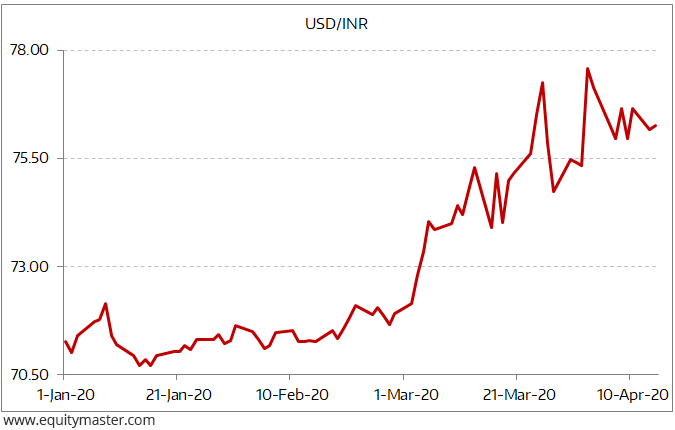India's Third Giant Leap
This Could be One of the Biggest Opportunities for Investors
- Home
- Todays Market
- Indian Stock Market News April 27, 2020
Sensex Opens Over 570 Points Up; Realty and Energy Stocks Rally Mon, 27 Apr 09:30 am
Asian stock markets are higher today as Chinese and Hong Kong shares show gains. The Shanghai Composite is up 0.6% while the Hang Seng is up 1.6%. The Nikkei 225 is trading up by 2.2%. Wall Street rallied on Friday, led higher by Apple and Microsoft as investors finished a turbulent week of trading and some states prepared to relax coronavirus-related lockdowns.
Back home, India share markets open higher. The BSE Sensex is trading up by 576 points while the NSE Nifty is trading up by 168 points. The BSE Mid Cap index and BSE Small Cap index opened up by 1.5% and 1.2% respectively.
All sectoral indices are trading in green with oil & gas stocks and realty stocks witnessing maximum buying interest.
Moving on, gold prices are currently trading up by 0.2% at Rs 46,527.
The rupee is currently trading at 76.29 against the US$.
As per an article in a leading financial daily, India's rupee could be the fastest in the region to rally as the world restarts economic activities after the coronavirus pandemic, oil prices weaken, and the US dollar eases broadly.
The Indian rupee has lost nearly 7% against the dollar so far this year, despite heavy dollar supplying intervention by the central bank. It hit a life low of 76.92 to the dollar on Wednesday last week.
But a turnaround could be swift because of the collapse in the price of oil, which is a major import for the country, and the return of foreign investment into rupee stocks and bonds, the reports noted.
On a year-to-date (YTD) basis, the rupee has depreciated sharply against the US dollar. While it started the calendar year 2020 at 71.28 against the US dollar, it is currently trading at 76.42 against the US dollar.
YTD Performance of the USD/INR

In a recent article titled The Sharp Fall in Indian Rupee: 6 Points to Know, we dive deeper and look at the factors behind rupee's depreciation.
We also reached out to Vijay Bhambwani, editor of Weekly Cash Alerts, who is closely tracking the Indian rupee in the current scenario. Here's what he has to say...
- The onset of Corona virus has not been kind to the INR.
The Rupee futures (USDINR) opened in March at 72.36 and have closed at 76.61 on April 09 2020. That is a decline of 5.87% in 6 short weeks.
The implications of the same will be widespread. India is a net importing Country. Everything that we import will now be more expensive. Approximately two thirds of all our imports are fossil fuels. Fuels are what we call multiplier effect commodities. If fuel prices rise at the petrol pumps, everything from fruits, vegetables, grains to dairy and poultry products get expensive.
That impact will be felt at a later date. I expect the trickle down effect to start appearing in prices after the April-June quarter is over.
I have already factored in this aspect in my statistical data model and plan to identify such events to generate profitable trading opportunities for my WCA plan subscribers.
Vijay has also talked about the Indian currency in a special edition podcast from Investor Hour. He shares what's around the corner for Indian rupee and how should position oneself for potential gains.
You can listen the entire episode here...

Moving on the to another news. Remaining risk-averse amid the coronavirus pandemic, overseas investors have withdrawn net Rs 103.5 billion from Indian capital markets in April so far.
Between April 1-24, foreign portfolio investors (FPI) pulled out a net sum of Rs 68.2 billion from equities and Rs 35.3 billion from the debt segment. The total net outflow stood at Rs 103.5 billion.
However, the quantum of outflows has reduced from March, when FPIs had withdrawn a record Rs 1.1 trillion on net basis from Indian markets (both equity and debt).
Emerging markets are considered to be a riskier investment destination and more prone towards crises of this magnitude.
With low-risk appetite, foreign investors drift towards safer investment avenues and safe havens such as US$ and gold.
To know what's moving the Indian stock markets today, check out the most recent share market updates here.
For information on how to pick stocks that have the potential to deliver big returns, download our special report now!
Read the latest Market Commentary


Equitymaster requests your view! Post a comment on "Sensex Opens Over 570 Points Up; Realty and Energy Stocks Rally". Click here!
Comments are moderated by Equitymaster, in accordance with the Terms of Use, and may not appear
on this article until they have been reviewed and deemed appropriate for posting.
In the meantime, you may want to share this article with your friends!